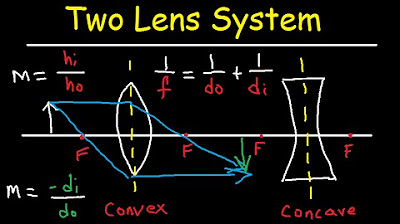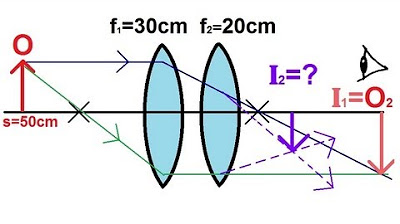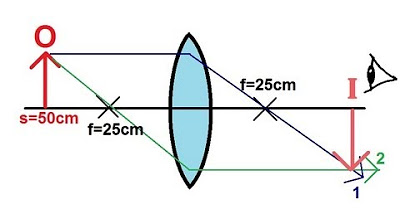Physics - Optics: Lenses (3 of 5) Lens Combinations - Converging & Diverging Lenses
TLDRThis educational video script discusses the effect of combining a converging lens with a focal length of 20 cm and a diverging lens with a focal length of -30 cm. It explains how the lenses interact, with the converging lens being stronger, resulting in a combined effect that still converges light but less intensely. The script guides through the process of finding the first image using lens equations and ray diagrams, revealing an inverted real image. It also calculates magnification and attempts to find the second image, concluding that it is at infinity due to the unique positioning of the first image at the focal point of the diverging lens.
Takeaways
- 🔍 The script discusses the effect of combining a converging lens with a focal length of 20 cm and a diverging lens with a focal length of -30 cm.
- 🌀 Convergent lenses are positive and cause light rays to converge, while divergent lenses are negative and cause light rays to diverge.
- 💪 The relative strength of the lenses is determined by their focal lengths; the smaller the focal length, the stronger the lens.
- 🤔 The combination of lenses will act as a converging lens if the converging lens is stronger, but the diverging lens will reduce its strength.
- 👀 The script explains the process of finding the first image by using rays parallel to the normal and through the focal point.
- ✂️ Magnification is calculated as the ratio of the image distance to the object distance, and it indicates whether the image is inverted and its size relative to the object.
- 🔢 The first image distance (s1') is calculated using the lens equation, resulting in a positive 40 cm, indicating a real image.
- 🔄 The first image becomes the object for the second lens, and the distance between the lenses affects the calculation of the second image.
- 🔄 The second lens calculation leads to an infinite image distance, meaning the rays never converge to form an image.
- 📚 The script emphasizes the importance of understanding lens combinations and their effects on image formation.
- 👋 The presenter invites viewers to return for the next video to see another example of lens combination and image formation.
Q & A
What is the focal length of the converging lens mentioned in the script?
-The focal length of the converging lens is 20 centimeters.
What is the focal length of the diverging lens mentioned in the script?
-The focal length of the diverging lens is -30 centimeters, indicating it is a negative lens.
Why do converging and diverging lenses contract with each other when combined?
-When combined, the converging lens causes the rays to converge while the diverging lens causes them to diverge, leading to a mutual 'contraction' effect due to their opposing actions.
How does the relative strength of the lenses in a combination affect their overall behavior?
-The overall behavior of the lens combination depends on their relative strengths, with the lens having the smaller focal length being stronger and causing the rays to bend more.
What happens to the strength of the first lens when a diverging lens is added to the combination?
-The strength of the first lens is 'diluted' by the diverging lens, resulting in the rays not converging as quickly and the image being formed farther away.
What is the process of finding the first image formed by the first lens?
-The first image is found by drawing a ray parallel to the normal that hits the lens and then diverges through the focal point on the other side, and another ray from the object to the focal point on the front side of the lens that continues straight parallel to the normal.
What is the equation used to find the image distance (s1 prime) of the first lens?
-The equation used to find the image distance of the first lens is s1 prime = s1 * F1 / (s1 - F1).
What does a positive image distance indicate about the image formed by the lens?
-A positive image distance indicates that the image is real, meaning it is formed on the opposite side of the lens from the object and can be projected onto a screen.
How is the magnification of the first lens calculated, and what does it represent?
-The magnification (m1) is calculated as m1 = -s1 prime / s1. It represents the ratio of the image distance to the object distance and indicates whether the image is inverted and by what factor the size of the image is scaled relative to the object.
What does it mean when the calculation for the second lens results in a zero denominator?
-A zero denominator in the calculation for the second lens indicates that the image is at infinity, meaning the rays after passing through the lens do not converge and continue indefinitely without forming a real image.
Why does the first image become the second object in the lens combination scenario?
-The first image becomes the second object because, in the lens combination, the image formed by the first lens acts as the object for the second lens, and the rays from this 'object' pass through the second lens to form another image.
Outlines
🔍 Combining Converging and Diverging Lenses
This paragraph discusses the concept of combining a converging lens with a focal length of 20 centimeters and a diverging lens with a focal length of -30 centimeters. It explains that when combined, the lenses' effects balance each other out, with the converging lens being stronger in this case. The result is a combined lens system that still converges light but with reduced strength, leading to a more distant image formation. The paragraph also details the process of finding the first image using lens formula and the concept of magnification, resulting in an inverted image of the same size as the object.
🌌 The Second Image at Infinity
The second paragraph delves into the implications of the first image becoming the object for the second lens. It explains that the first image is located at the focal point of the diverging lens, which causes the light rays to diverge indefinitely without converging to form an image. This results in the second image being effectively at infinity, a situation where the rays never meet to form a focal point. The paragraph concludes by indicating that a different example will be shown in the next video to illustrate a scenario where the second image is not at infinity.
Mindmap
Keywords
💡Converging Lens
💡Diverging Lens
💡Focal Length
💡Lens Combination
💡Ray Tracing
💡Image Formation
💡Magnification
💡Object Distance
💡Image Distance
💡Virtual Image
💡Infinity
Highlights
Introduction to combining a converging lens with a focal length of 20 cm and a diverging lens with a focal length of -30 cm.
Converging lenses are positive lenses; diverging lenses are negative lenses.
The combined effect of converging and diverging lenses depends on their relative strengths.
The smaller the focal length, the stronger the lens, causing more bending of rays.
In this example, the converging lens is stronger, so the combination will act like a converging lens.
The diverging lens dilutes the strength of the converging lens, causing rays to converge less quickly.
Using the lens equation to find the image distance for the first lens.
Calculation for the first image distance: s1' = s1 * F1 / (s1 - F1).
With object distance s1 = 40 cm and focal length F1 = 20 cm, the first image distance is 40 cm.
The first image is a real image located 40 cm past the second lens.
Calculating the magnification of the first lens: m1 = -s1' / s1, resulting in -1.
The image is inverted but the same size as the object for the first lens.
Using the lens equation for the second lens: s2' = s2 * F2 / (s2 - F2).
Object distance for the second lens is -30 cm, resulting in an image distance at infinity.
Explanation that the rays diverge to the point of never coming together, forming an image at infinity.
Transcripts
Browse More Related Video

Multiple Two Lens System with Diverging and Converging Lens

Physics - Optics: Lenses (1 of 5) Lens Combinations - Two Converging Lenses

Physics - Optics: Lenses (2 of 2) Diverging Lens

Physics - Optics: Lenses (1 of 4) Converging Lens

Physics - Optics: Lenses (4 of 5) Lens Combinations - Converging & Diverging Lenses

Physics - Optics: Lenses (2 of 4) Converging Lens
5.0 / 5 (0 votes)
Thanks for rating: